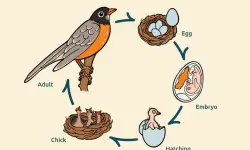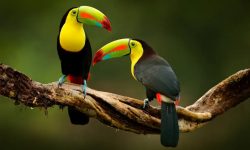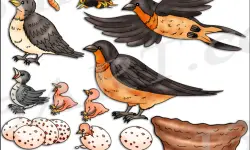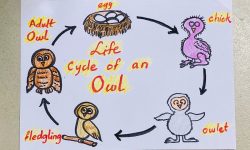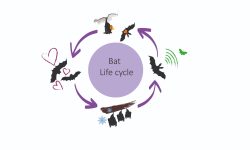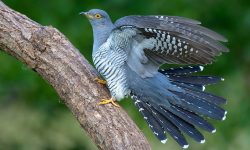Washington State is home to a stunning variety of landscapes—from mountain ranges and evergreen forests to arid shrublands and coastal wetlands. These diverse habitats make the state an ideal home for a wide range of raptors, especially hawks. Whether you’re birdwatching in Olympic National Park or scanning the skies over the Palouse, you’re likely to spot one of these majestic birds of prey. In this guide, we’ll introduce you to 10 hawk species that can be seen throughout Washington.
1. Red-tailed Hawk (Buteo jamaicensis)
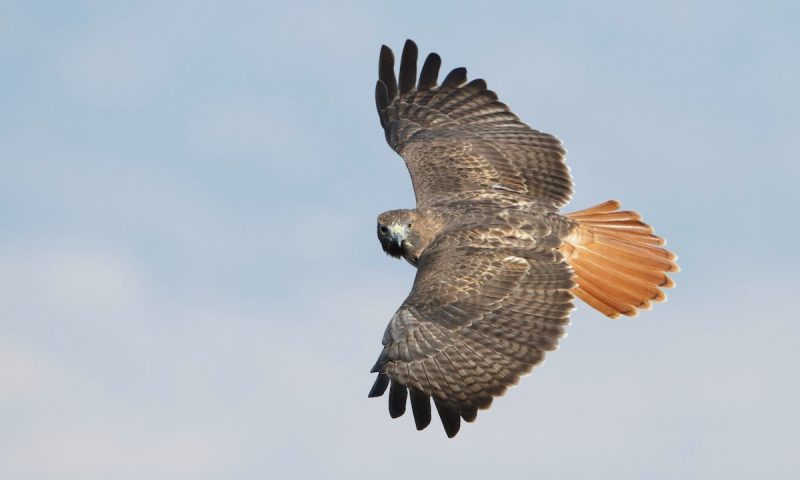
The Icon of Washington’s Skies
No other hawk defines the American sky quite like the Red-tailed Hawk. With its broad, soaring wings and signature brick-red tail, this raptor is a symbol of wilderness and open space. In Washington, it’s almost everywhere—gliding in wide circles over golden farmlands, perched stoically on fence posts, or screeching overhead in a voice that Hollywood often borrows for every eagle scene.
Where to Spot
If you’ve looked up while driving down an open highway, chances are you’ve seen one. Red-tailed Hawks are year-round residents across Washington, thriving in places where forest meets field. Keep an eye on utility poles, dead trees, and cliff edges—they love high, open perches with a commanding view of potential prey.
What They Eat
Masters of patience, Red-tailed Hawks sit still for hours before swooping down on unsuspecting prey. Their menu includes mice, voles, rabbits, and even the occasional snake or songbird. They’re generalists—as adaptable in diet as they are in habitat—which is why they’ve made themselves at home from the dry sagebrush of Eastern Washington to the lush lowlands west of the Cascades.
2. Cooper’s Hawk (Accipiter cooperii)
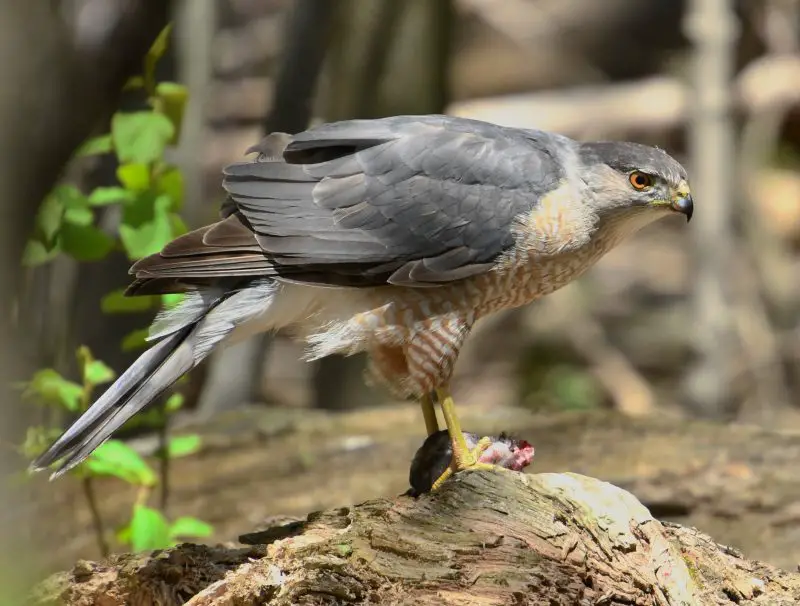
The Stealthy Backyard Hunter
Fast, fierce, and unbelievably agile, the Cooper’s Hawk is the ninja of the raptor world. Built like a missile with feathers, this sleek forest hawk is designed for high-speed chases through tight spaces, darting between branches with breathtaking precision. If you’ve ever seen a flurry of feathers erupt at your bird feeder, chances are a Cooper’s Hawk just made a surprise appearance.
Where to Spot
Once a secretive forest dweller, this hawk has boldly expanded into suburban neighborhoods and city parks. It now thrives wherever songbirds gather—especially around feeders. You might not notice one until it swoops low across your yard and disappears into the trees like a shadow.
What They Eat
Cooper’s Hawks are bird specialists. Their favorite meals include doves, robins, sparrows, and starlings—often caught in midair with stunning agility. They’ll occasionally go after chipmunks or squirrels, but feathered prey is their go-to. If you’re a songbird, this hawk is your worst nightmare.
3. Sharp-shinned Hawk (Accipiter striatus)
Small Body, Big Attitude
Don’t underestimate the Sharp-shinned Hawk—it may be the tiniest hawk in North America, but it packs the heart of a much larger predator. Sleek, swift, and incredibly daring, this bird is like a feathered bullet, built for speed, stealth, and sudden ambushes. Its boldness far outweighs its size, and it’s not afraid to chase prey through thickets that would stop larger raptors in their tracks.
Where to Spot
Spotting a Sharp-shinned Hawk often requires sharp eyes and a bit of luck. They’re most visible during fall migration, especially along forest ridgelines and open clearings, where they streak by in a zigzagging blur. In winter, they may show up at backyard feeders—not for seed, but for the songbirds gathered there.
What They Eat
This hawk has a taste for feathers. It specializes in catching small birds, such as warblers, finches, and sparrows. Rather than soaring, it relies on surprise—darting from cover and seizing its prey mid-flight or in dense foliage. Quick, quiet, and ruthless, the Sharp-shinned Hawk is the woodland assassin few see coming.
4. Northern Harrier (Circus hudsonius)
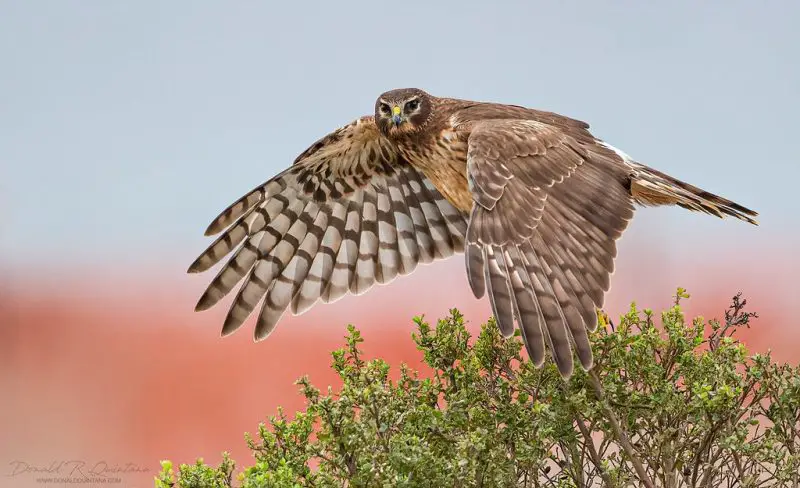
The Ghost of the Marshlands
With wings held in a graceful V and a slow, floating flight just feet above the ground, the Northern Harrier seems to glide on air itself. Nicknamed the “owl hawk” for its rounded facial disc and stealthy hunting style, this raptor brings an eerie beauty to wetlands and open fields. It doesn’t dive or pounce like other hawks—instead, it haunts the landscape, scanning and listening for the faintest rustle below.
Where to Spot
You’ll most often find this elegant hunter sweeping silently over meadows, marshes, and agricultural fields, especially in the Skagit Valley, Columbia Basin, and other open areas. Males are pale gray with black wingtips, while females are larger and rich brown—both unmistakable in flight.
What They Eat
Unlike most hawks, Northern Harriers rely heavily on sound as well as sight. Their owl-like face funnels noise to their ears, letting them hear the movements of voles, frogs, or songbirds hiding in the grass. Their diet includes small mammals, ground-nesting birds, reptiles, and even the occasional insect. Graceful but deadly, they are among the most specialized hunters in the hawk world.
5. Rough-legged Hawk (Buteo lagopus)
The Feathered Nomad from the North
Straight from the frozen frontiers of the Arctic, the Rough-legged Hawk arrives in Washington each winter like a silent envoy of the far north. With legs fully feathered to the toes—a rare trait among hawks—it’s built to brave brutal temperatures and windswept tundra. Everything about this bird whispers of endurance and ice.
Where to Spot
As snow creeps into the mountains and daylight wanes, Rough-legged Hawks descend into open spaces like the Columbia Plateau, Yakima Valley, and other vast, windswept regions. Look for them hovering midair, wings fluttering and tail fanned, as they search the grasslands below—a behavior more commonly seen in kestrels.
What They Eat
Small mammals are their winter staple. They scan for voles, mice, and other burrowers scurrying beneath the frosted earth. In their Arctic breeding grounds, lemmings make up a massive portion of their diet. When prey is scarce, they’re known to switch to birds or carrion, but their patience and skill in cold-weather hunting are second to none.
6. Swainson’s Hawk (Buteo swainsoni)
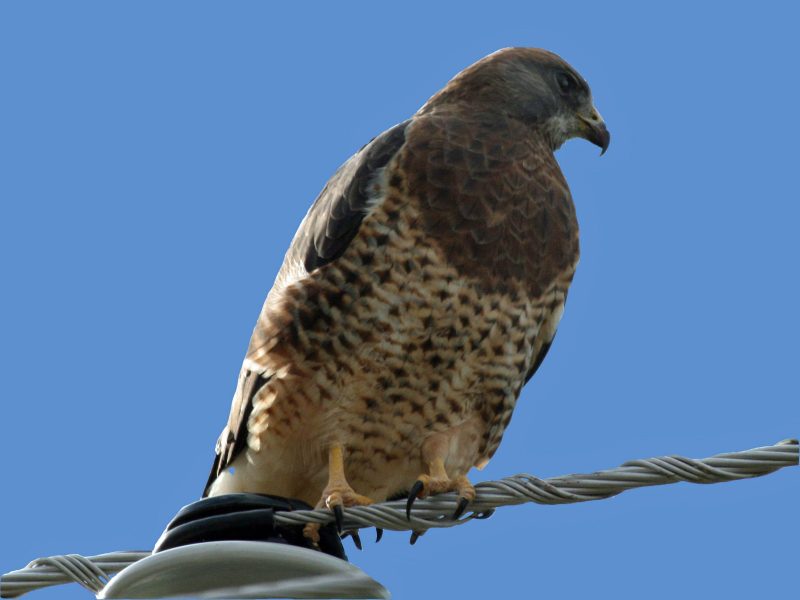
The Sky Traveler
Few birds match the Swainson’s Hawk when it comes to wanderlust. Each year, this elegant raptor makes an epic migration from the grasslands of eastern Washington all the way to the plains of Argentina—a journey of over 6,000 miles one way. In the world of hawks, it’s a long-distance legend.
Where to Spot
These hawks arrive in eastern Washington during late spring and stay through summer to breed. They favor open country—vast grasslands, sagebrush flats, and agricultural fields—where they can perch on fence posts and scan the horizon for movement. Look for them in the Palouse or along the Columbia Basin, soaring high with long, pointed wings and dark flight feathers.
What They Eat
Swainson’s Hawks are versatile feeders. During nesting season, they hunt ground squirrels, gophers, and snakes, providing high-protein meals for their chicks. But once the breeding job is done and migration begins, they transform into something unusual for a raptor: an insectivore. On the move, they gorge on grasshoppers, dragonflies, and beetles in swarms, often following plowed fields and agricultural burns across continents.
They may look like typical hawks at first glance—but beneath those wings is the spirit of a global traveler, adapted to two hemispheres and powered by instinct and wind.
7. Ferruginous Hawk (Buteo regalis)
The Vanishing Giant of the Grasslands
Regal by name and regal in appearance, the Ferruginous Hawk is the largest hawk species in North America—and one of the rarest raptors in Washington. With its broad wings, snowy belly, and burnt-copper “ferruginous” shoulders, this hawk looks like it belongs to a forgotten era of open skies and untamed plains. Sadly, it’s now a species of concern, its numbers dwindling as wild grasslands vanish beneath agriculture and development.
Where to Spot
Ferruginous Hawks haunt the sun-baked sagebrush and dry grasslands of south-central Washington, particularly around the Hanford Reach National Monument. These vast, open spaces are crucial to their survival. Look for them perched low—on rocks, fence posts, or even directly on the ground—eyes locked on the horizon.
What They Eat
This hawk is a ground-hunter by design. Its diet centers around ground squirrels, prairie dogs, and jackrabbits, which it snatches up with surprising speed. Unlike forest-dwelling hawks, Ferruginous Hawks rely on low glides, quick dives, and stealthy ground perching to ambush prey in the open. When they take flight, their enormous wingspan and graceful glide are unforgettable—a ghost of the prairie skies.
8. Northern Goshawk (Accipiter gentilis)
The Phantom of the Forest
Stepping into an old-growth forest, where the trees close in and the light fades, you enter the hidden world of the Northern Goshawk—a raptor so secretive and swift it’s often called the ghost of the woods. Larger and more powerful than its accipiter cousins, this bird is built for ambush, cutting through tangled branches with terrifying speed.
Where to Spot
Catching a glimpse of a Goshawk in Washington is a rare privilege. They dwell deep within mature coniferous forests of the Cascade and Olympic Mountains, far from human noise. Their presence is often betrayed not by sight, but by sound—a loud, piercing “kak-kak-kak” echoing through the trees.
What They Eat
Northern Goshawks are versatile and relentless hunters, capable of taking down prey nearly their own size. They feast on medium-sized birds like jays and grouse, and hunt snowshoe hares, squirrels, and rabbits with lethal precision. Unlike soaring hawks, they burst from cover like a missile, striking without warning. In their shadowed world, few creatures are safe once the Goshawk locks in.
9. Broad-winged Hawk (Buteo platypterus)
A Secretive Traveler Passing Through
The Broad-winged Hawk isn’t a familiar face in Washington skies, but when it appears, it’s part of something much bigger. Each fall, these compact raptors join thousands of others in one of the most awe-inspiring spectacles of migration—sky rivers of hawks, flowing south in great spirals called kettles. While they’re common back East, in Washington, they’re rare migrants, quietly slipping through the state’s eastern edges.
Where to Spot
Your best chance to see one is during autumn migration, especially over the Blue Mountains or known flyways in southeastern Washington. Watch for small, stocky hawks with banded tails and broad wings, gliding silently with dozens—or even hundreds—of others high overhead.
What They Eat
In their preferred woodland habitats, Broad-winged Hawks hunt a wide variety of prey. Their diet includes small mammals, frogs, lizards, snakes, and even large insects. Quick and opportunistic, they often wait patiently in shaded perches before swooping down in a sudden, calculated strike.
Though they pass through quickly and in small numbers, the Broad-winged Hawk brings with it the mystery of long journeys and the beauty of migration in motion.
10. Osprey (Pandion haliaetus) – Honorable Mention
The Fisher-King of Washington Waters
While not a true hawk by classification, the Osprey earns its place on any list of raptors through sheer spectacle. With a wingspan stretching up to six feet and talons sharper than fishhooks, this expert angler rules the skies above lakes, rivers, and estuaries. Watch one dive—and you’ll see why it’s often called the “fish-hawk.”
Where to Spot
Ospreys are widespread across Washington from spring through early fall. They nest near freshwater bodies like the Puget Sound, Lake Washington, and the Columbia River, often building massive stick nests atop utility poles or tall dead trees. Their piercing calls—like high-pitched whistles—are a familiar sound in shoreline air.
What They Eat
The Osprey’s diet is nearly 100% live fish. With a keen eye from above, it spots its prey and then dives feet-first, plunging into the water with incredible force. Its reversible outer toes and barbed footpads help it grip slippery fish as it lifts off and carries the catch head-first to reduce drag.
Graceful in the air and brutal underwater, the Osprey is a marvel of specialization—a raptor evolved not for forests or fields, but for the glint of water and the flash of a fin.
Final Thoughts
Washington’s landscape is a haven for hawks—from the towering Cascades to the windswept plains of the Columbia Plateau. Whether you’re a seasoned birder or just learning to recognize silhouettes overhead, these ten species showcase the power, diversity, and adaptability of raptors in the Pacific Northwest.
Be sure to bring your binoculars, look to the sky, and respect the habitats that allow these birds to thrive. With a bit of patience and luck, you might spot more than just one of these magnificent hunters on your next outing.

